After weeks of testing ShortStack and Wishpond in real-world marketing scenarios, we’ve learned that each has unique strengths that cater to different business needs, particularly in lead generation, campaign creation, and audience engagement.
ShortStack is a simple and user-friendly tool for building interactive content like contests, giveaways, and landing pages. Its intuitive drag-and-drop interface and customization features make it a great option for businesses looking to run engaging campaigns. It’s best used for creating compelling gamified forms to collect user information but doesn’t come with many built-in tools for quizzes, personalization, and customer journeys, meaning you’ll need some development skills to get the most out of it.
Then there’s Wishpond. It’s a more comprehensive marketing solution than ShortStack because it combines lead generation, email marketing, and automated workflows under one roof. With built-in tools for creating forms, landing pages, and pop-ups, it’s a good choice for businesses looking to grow their lead database. On the other hand, Wishpond places less emphasis on advanced user engagement and mostly focuses on email marketing performance.
That’s why we included Wyng in this comparison.
Wyng excels at creating a wide range of personalized interactive experiences, such as photo and video contests, proof-of-purchase sweepstakes, instant wins, and voting contests. It includes built-in risk management and fraud prevention features like CAPTCHA tests and identity verification. In addition, Wyng combines seamless CRM, CDP, and ESP integrations with personalized technical and strategic customer services, making it the ideal solution for enterprises looking to run recurring promotions to engage audiences and collect data.
In this article, we’ll compare ShortStack vs Wishpond and see how Wyng stacks up against them across five key areas:
- Interactive Experiences and Gamification
- Audience Growth and Conversion
- Data Collection and Personalization
- Analytics and Reporting
- Pricing
Before diving into the details, here’s an overview of the comparison in the table below.
ShortStack vs Wishpond vs Wyng: Comparison Summary
| ShortStack | Wishpond | Wyng |
|---|---|---|
 |  |  |
Interactive Experiences and Gamification | ||
⭐⭐⭐ Form-based contests with voting widgets. Gamified social media contests and point-based reward systems. No built-in quiz components, requires custom code. | ⭐⭐ Contest templates for social media platforms with entry moderation. No quiz builder or templates. Lacks advanced engagement features. | 🏆 Built-in tools for UGC photo/video contests, proof-of-purchase sweepstakes, voting, and instant wins with CAPTCHA protection. Engagement features like scratch-offs and spin-to-win. Comprehensive quiz flow builder with scoring. |
Audience Growth and Conversion | ||
⭐⭐⭐ Basic form builder with 17 field types, custom fields, and a landing page builder. Limited pop-up functionality. No website builder. Custom widget interaction logic. | 🏆 Full website builder with AI content generation, A/B testing on landing pages, and customizable pop-ups with trigger rules. Comprehensive forms integration. | 🏆 Experience Studio for forms, landing pages, and interactive content. Advanced form builder with fraud detection, identity verification, and unique field types. Flexible pop-ups via inline/iFrame embedding + the Moments feature. |
Data Collection and Personalization | ||
⭐⭐⭐ Basic email list management with campaign-specific databases. Built-in form integrations limited to Google Maps/Mailchimp. No personalization tools beyond basic content visibility controls. | ⭐⭐⭐⭐ Smart and static lead lists with behavior tracking. Basic automated workflows. Customer segmentation based on lists, behavior, and campaign interactions. | 🏆 Best for data collection with privacy-first customer profiles. Seamless third-party integrations. Advanced personalization through segments, with adaptive content and rewards. |
Analytics and Reporting | ||
⭐⭐⭐⭐ Basic campaign analytics with traffic, clicks, entries, sharing, and autoresponder metrics. Shows geographical and device-type data. | ⭐⭐ Real-time reporting dashboards, mostly focusing on email campaign metrics: sends, opens, clicks, and lead capture rates. | 🏆 Comprehensive analytics with seven dashboards covering visitors, engagement, forms, content, and profile metrics. Includes detailed attribute tracking. |
Customer Support | ||
⭐⭐⭐⭐ Help center, live chat, email, and account manager. | ⭐⭐⭐⭐ Knowledge base, chat, phone, email, and marketing team. | 🏆 Help center, developer portal, email, and account manager. Wyng Services for technical and strategic support. |
Integrations | ||
⭐⭐ Google Maps, Mailchimp, and Webhooks | 🏆 300+ integrations, including Mailchimp, Salesforce, and Active Campaign | ⭐⭐⭐⭐ 17 native integrations with CRMs, CDPs, and ESPs + Webhooks and Wyng API |
Best For | ||
Small to mid-sized businesses and marketers looking to create interactive forms, landing pages, and social media contests. | Businesses that need an all-in-one digital marketing toolkit for creating, optimizing, and deploying marketing campaigns. | Enterprises that need advanced audience engagement tools, compliant data collection, and powerful analytics to augment their marketing efforts. |
What is ShortStack?
“Power Your Campaigns with Social Media” 🚀
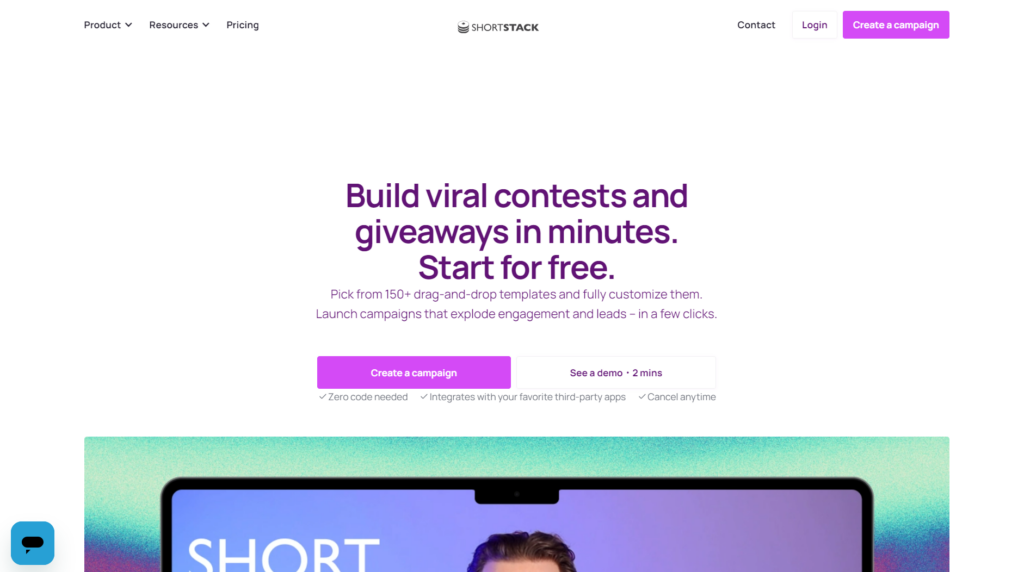
Formerly a boutique design agency, ShortStack was founded in 2010 by Jim Belosic and Doug Churchill. It was born out of a desire to provide a DIY tool to businesses for creating professional-looking, lead generating digital content.
ShortStack’s engagement platform includes a drag-and-drop landing page builder, customizable forms with 17 field types, and the ability to embed interactive elements such as quizzes and gamified scoring systems. It also allows you to implement custom HTML, CSS, and JavaScript code to personalize your landing pages and forms further. ShortStack offers essential user engagement tools like random winner selection for giveaways and contests, as well as basic analytics for tracking traffic and user interactions.
It’s ideal for small to mid-sized businesses and marketers that need an affordable platform to collect customer information using gamified, interactive content.
What is Wishpond?
“All-in-One Marketing to Grow Your Business” 🌱

Wishpond was founded in 2009 by Ali Tajsekandar after he noticed many small businesses were struggling with the high costs and complexity of marketing campaign platforms.
Wishpond’s all-in-one platform includes a drag-and-drop landing page builder with A/B testing for optimization, a full-featured website builder, and email marketing tools. Wishpond also integrates customizable customer engagement options such as social promotions, customer segmentation tools for optimized marketing automation workflows, and a robust leads database. Its focus on user-friendly design and automation makes it a versatile tool for various marketing tasks.
Wishpond is designed for small businesses that need a complete digital marketing toolkit for creating, optimizing, and deploying online marketing campaigns.
What is Wyng?
“Create Engaging Experiences That Convert” 🎯

Wendell Lansford and Prakash Mishra founded Wyng in 2010 after being frustrated with traditional marketing strategies. They set out to create a platform that helps brands achieve their goals by prioritizing consumer experiences.
The Wyng Experience Studio offers a variety of widgets, including customizable forms, quizzes, contests, and voting systems. It also includes a large range of interactive user engagement experiences such as scratch-offs and spin-to-win games with built-in fraud detection and identity verification. Wyng stands out with its focus on zero-party data collection, which gives customers control over the data they share and at the same time enables powerful personalization for tailored experiences. Furthermore, it provides data integrations with CRMs, CDPs, and ESPs, and offers technical and strategic customer support.
Wyng is the ideal solution for enterprises looking to run regular and recurring interactive promotions to engage audiences and collect data. It provides features optimized for enterprise user engagement needs like advanced security controls, automatic Experience language translation, and account governance with team management.
ShortStack vs Wishpond vs Wyng: Interactive Experiences and Gamification
Wyng provides built-in tools for contests, quizzes, and interactive experiences, while ShortStack and Wishpond rely on custom code and templates.
| ShortStack | Wishpond | Wyng |
|---|---|---|
⭐⭐⭐ | ⭐⭐ | ⭐⭐⭐⭐⭐ |
Contest and Giveaway Tools: ShortStack supports contests and voting with landing page widgets, Wishpond provides some contest templates, while Wyng offers a wide array of built-in contest, voting, and giveaway tools.
ShortStack specializes in social contests and giveaways. Offering over 150 templates, it allows you to create customizable hashtag contests for Instagram and comment contests for Facebook, Instagram, or YouTube.

ShortStack generally uses its form and landing page builder to create contests and giveaways. For example, you can use the File Upload and Text form fields to collect an image entry and its caption during a photo contest.
It also includes the Entry Search and Entry Display form widgets which allow participants to find and display entries from other participants. The Entry Display widget supports voting and even lets you select which form fields to show.
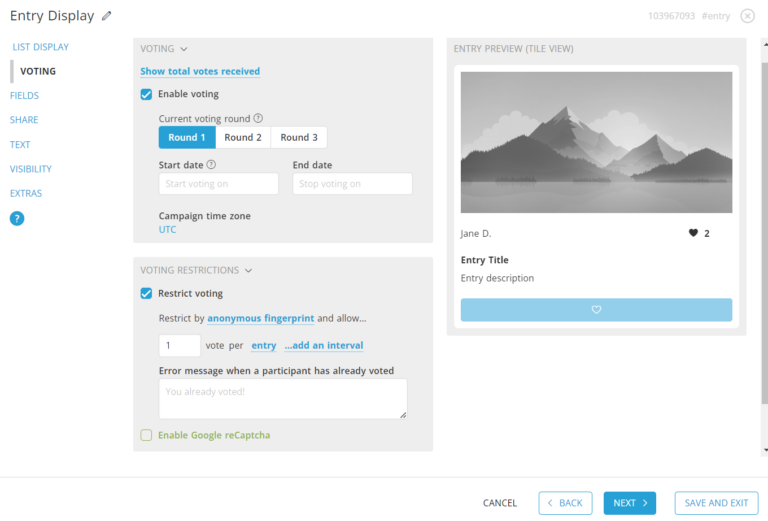
For giveaways, ShortStack simply collects and stores form entries, allowing you to select a winner at random, or based on any other deciding factor.
Wishpond claims to offer 11 types of social media contests and competitions, but these seem like regular form templates tailored to each contest type. Some unique templates include:
- Referral
- Sweepstakes
- Pinterest Contest
- Essay Competition
- Bonus Entry Contest
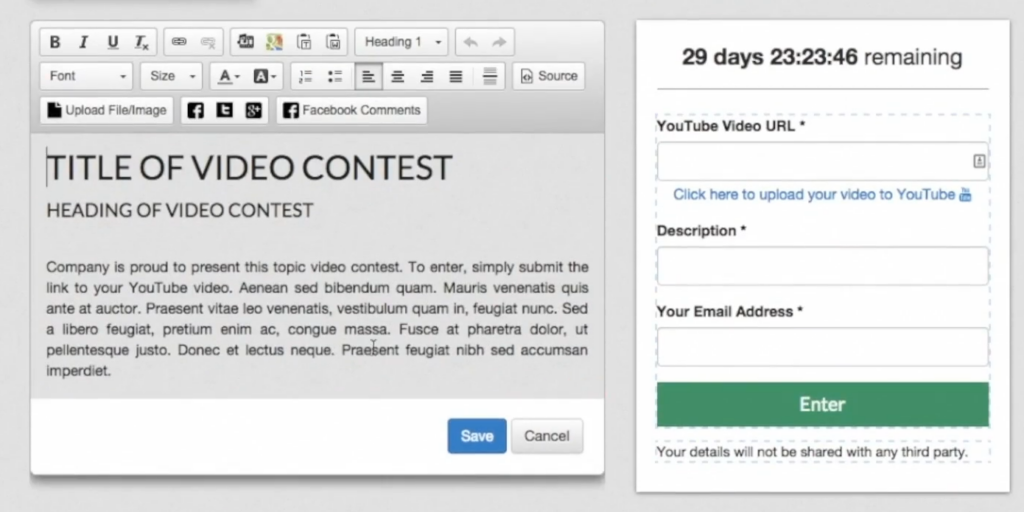
You can host Wishpond contests on your Facebook page, X, WordPress, Mobile, or your custom websites and blogs. Since it uses the same builder as forms and landing pages, you can A/B test your contest forms for optimization.
Wishpond supports entry moderation, allowing you to vet user entries for inappropriate content before they’re visible to other participants. It also lets you customize the voting schedule so you can choose whether to allow entries and voting simultaneously or enable voting after all entries have been submitted.
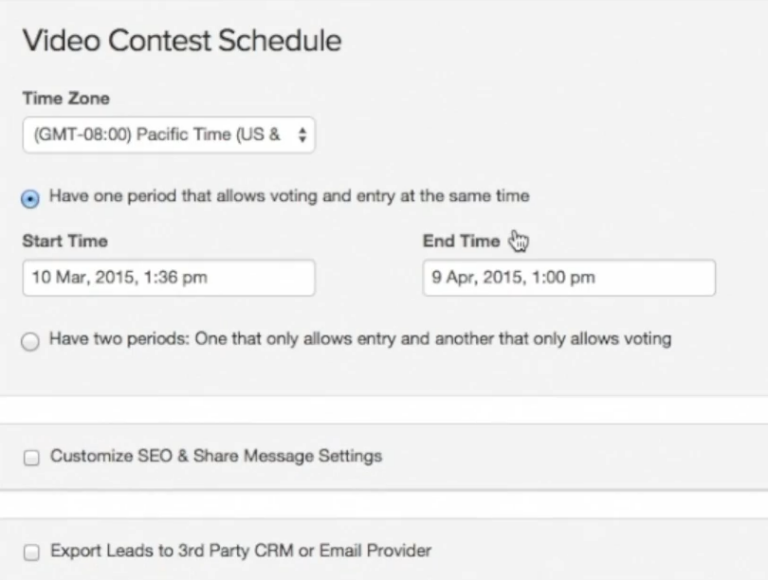
Both platforms offer pretty decent contest and giveaway tools, but these tools are essentially just specialized form and landing page templates.
This is where Wyng comes into play.
The Wyng Experience Studio provides several widgets for building interactive Experiences from a blank slate or by choosing a pre-built template in a huge library. Each template is designed for a specific use case:
- Social & UGC
- Sweeps & Promos
- Quizzes & Surveys
- Coupons & Samples
- Progressive Data Capture
- Gamification & Instant Win
- Recommend Products & Content
- Collect Preferences & Zero-Party Data
If we narrow it down to promotions like contests and giveaways, Wyng supports UGC photo and video contests, instant wins, proof-of-purchase sweepstakes, and voting.
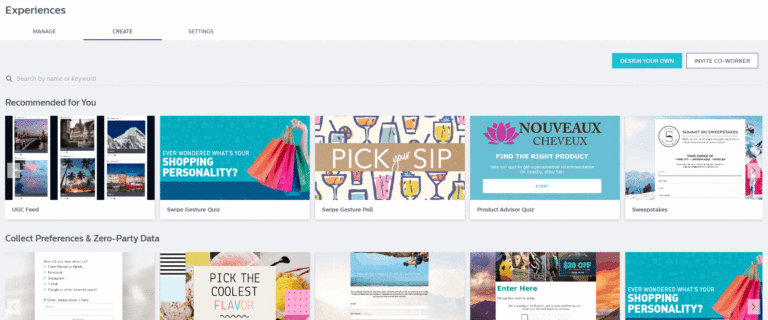
The robust UGC functionality allows you to collect, moderate, and display UGC via direct upload or social media ingestion. You can also automatically secure rights to content, so it’s easy to repurpose photos and videos from UGC contests in other ways. For example, UGC can drive sales by highlighting customer-preferred products to ease pre-purchase anxiety.
Wyng lets you reward winners and participants with single-use coupons, free samples, or any other content you want to offer. Meanwhile, you get their zero-party data with full consent, while respecting privacy and data regulations.
You also have the flexibility to customize your contest Experience however you want. For example, you can customize the vote icons and require a CAPTCHA submission to eliminate non-human votes. But that’s not all. Wyng offers easy language translation for Experiences, shared privacy policies, and shared account governance — key features especially useful for enterprises with recurring, global promotions.
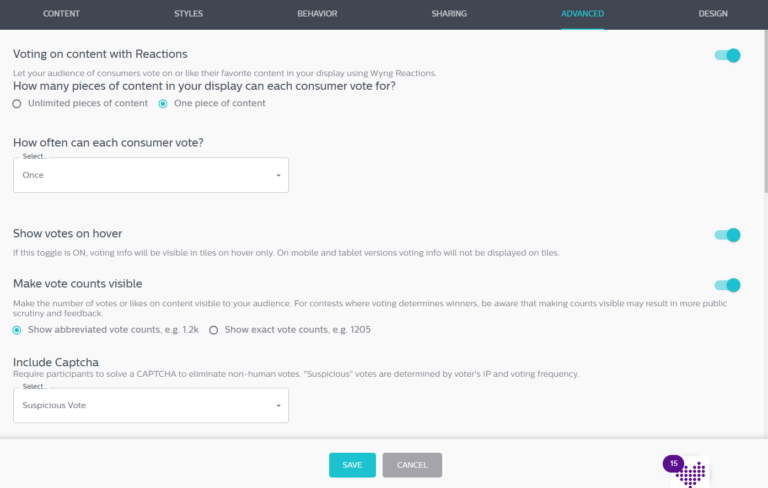
User Engagement: Wyng has built-in user engagement tools, while ShortStack relies on code templates, and Wishpond lacks dedicated engagement features.
When it comes to more complex user engagement methods such as scratch-offs and spin-to-wins, ShortStack handles that with custom HTML and JavaScript code. As a result, you’re forced to rely on simpler templates or hire a developer.
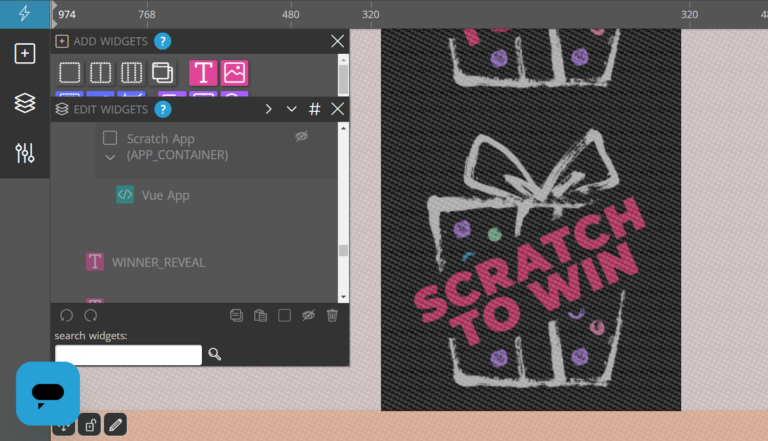
To boost engagement and keep users incentivized, ShortStack offers points for user actions like form submissions, social media interactions, voting, and other activities. Participants can then exchange these points for rewards or a higher chance of winning giveaways.
Wishpond doesn’t provide any dedicated, advanced user engagement features. Instead, you must mix and match existing features to create engaging user experiences.
On the other hand, Wyng has you covered when it comes to advanced user engagement.
We have mentioned all the different types of Experiences you can build with Wyng but we also wanted to highlight the customization options available to optimize every single Experience. For example, the spin-to-win widget lets you add as many spin sectors as you want, and even map multiple sectors to the same reward. Furthermore, you can customize the outcomes of the content, offering single-use codes, coupons, and other rewards.

If you need more customization over the scratch-off/spin-to-win Wyng even provides a JavaScript SDK that lets you build custom widgets and outcome logic.
In addition, Wyng gives you the flexibility to distribute Experiences however you want. Whether you want to embed Experiences directly on your site, share them as standalone landing pages, or even display them in-app, Wyng makes it possible.
Quizzes: ShortStack and Wishpond don’t provide built-in quiz creation tools, while Wyng provides a flow builder for quizzes and questionnaires.
ShortStack doesn’t provide any dedicated tools for creating quizzes. Instead, you have to craft quiz questions with the standard form and landing page widgets the builder provides. As you can expect, this process is time-consuming and error-prone.
You can use templates to try to speed up your workflow, but the quiz templates provided use custom HTML and JavaScript code. This means that you’ll need help from a developer to create quizzes if you can’t code yourself.
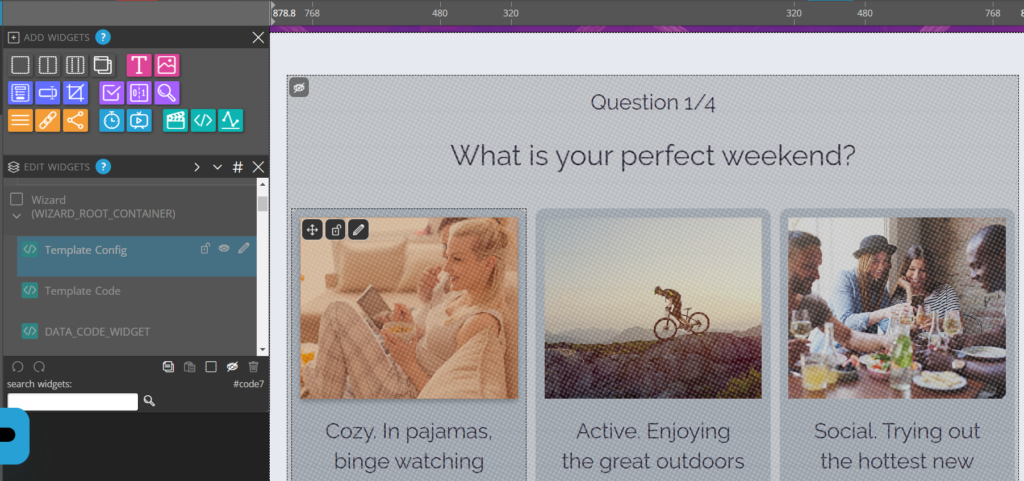
Wishpond doesn’t fare any better, with even fewer quiz creation conveniences than ShortStack. As of writing this article, it doesn’t have any quiz templates, which means you must build out your quizzes from scratch using custom code.
Wyng wins by a landslide in this category.
Not only does it provide a dedicated quiz component in its Experiences, but it also includes a handy flow builder for chaining questions, forms, and other components together.
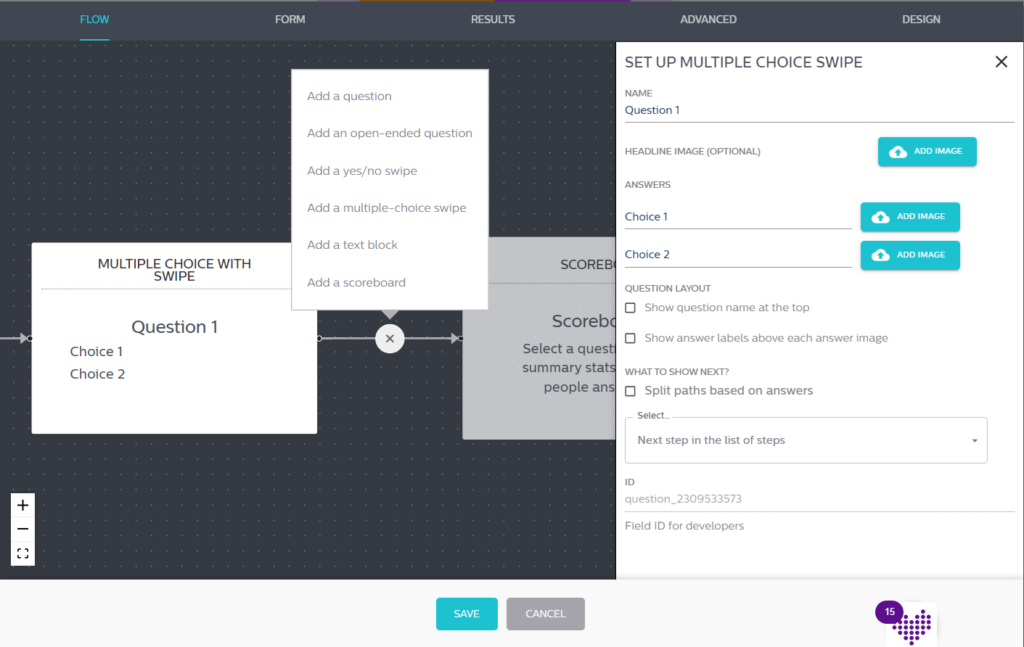
Each question type is highly customizable, supporting image options, split paths based on answers, auto advancement, and custom answer layout. Wyng also lets you insert a scoreboard after each question, so users can see how other participants answered it — great for trivia quizzes or polls.
Participants can see their performance on the Results page at the end of the quiz. And you can also insert a progress bar for participants to see how far along they are on the quiz.

Every quiz can become more than a simple quiz. You can add a spin-to-win wheel and make it into an interactive contest. Wyng includes many more customizations that let you create unique experiences for all participants. All the answers the participants share can be built into a customer profile — you get a direct insight into their interests. And the best part? You don’t need to hire developers to bring your Experiences to life, Wyng provides all the tools you need out of the box.
ShortStack vs Wishpond vs Wyng: Audience Growth and Conversion
ShortStack offers a standard form and landing page builder, Wishpond adds a website builder and A/B testing on top, and Wyng has a comprehensive builder for creating forms, landing pages, and unique web content.
Form Creation and Management: ShortStack provides customizable fields, Wishpond has a standard form builder, while Wyng offers unique field types, built-in fraud detection, and identity verification.
| ShortStack | Wishpond | Wyng |
|---|---|---|
⭐⭐⭐⭐ | ⭐⭐⭐⭐ | ⭐⭐⭐⭐⭐ |
ShortStack provides a form container in its landing page builder with 17 built-in field types, including:
- Name
- Phone
- Address
- Code Redemption
It also lets you create custom fields with Text, Boolean (Yes/No), Multiple Choice, Data, or Number values. You can customize the input style of each field, or set it hidden so it contains values that depend on other form entries.
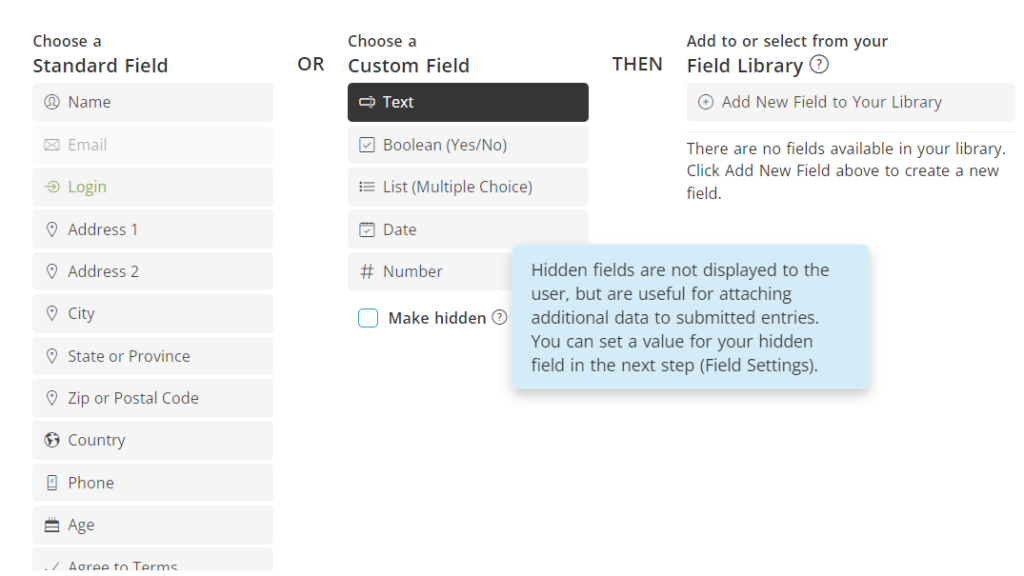
ShortStack’s form fields are highly customizable with location-based visibility, custom HTML and CSS tags and classes, and field points (gamified scores) for completed fields.
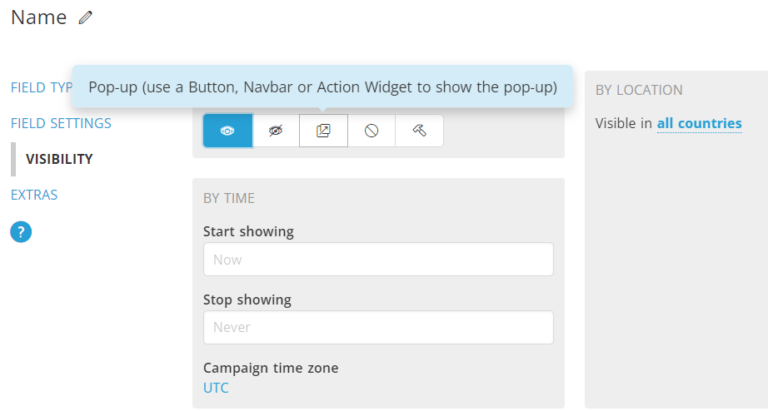
Wishpond’s form builder is integrated into its landing page builder with no particular standout features. It allows you to define custom form fields and store submissions in its Leads database.
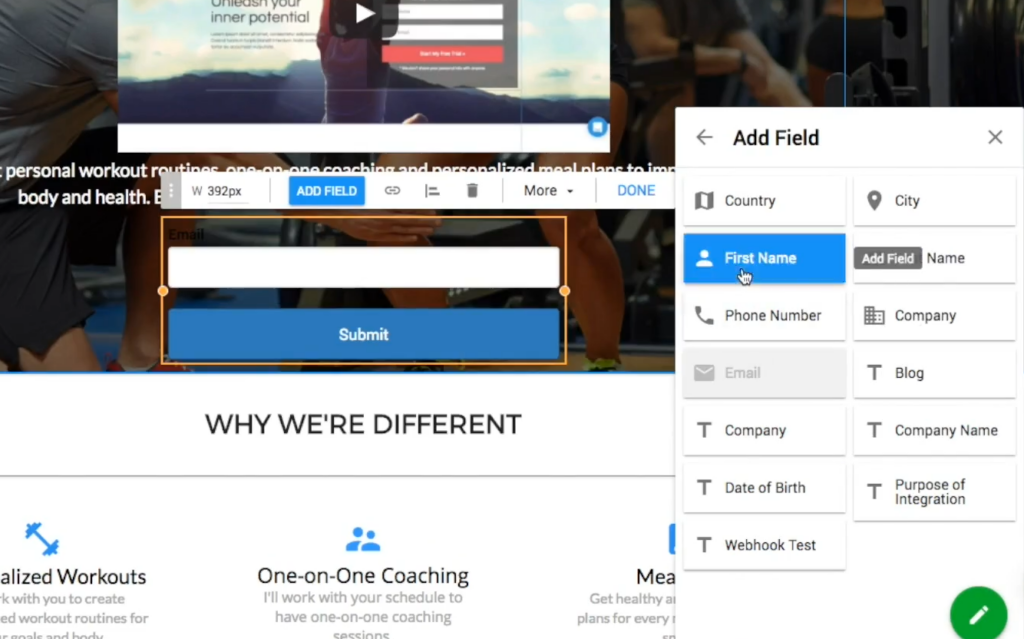
The Wyng Experience Studio helps you to create interactive experiences with more capabilities than the standard forms offered by ShortStack and Wishpond.
The Experience Studio provides many widgets, including the Form component, which you can embed into your website or have it published independently. It contains many more built-in form fields than the other two platforms, with unique fields like:
- URL
- Password
- Radio Button
- Multi Select Checkbox
- International Phone Number
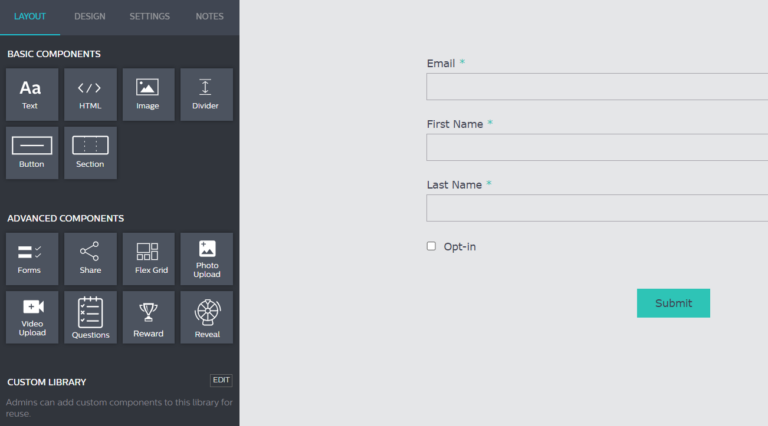
Wyng provides built-in audience growth and regulation tools, such as unique referral codes, participation limits, and share tracking. You can also create exclusive content using hidden form fields and single-use codes.
If you need fraud detection tools, Wyng Forms include built-in CAPTCHA and identity verification by phone or email. This helps you ensure that participants can’t use bots and other spam agents to send in multiple responses in an attempt to win contests.
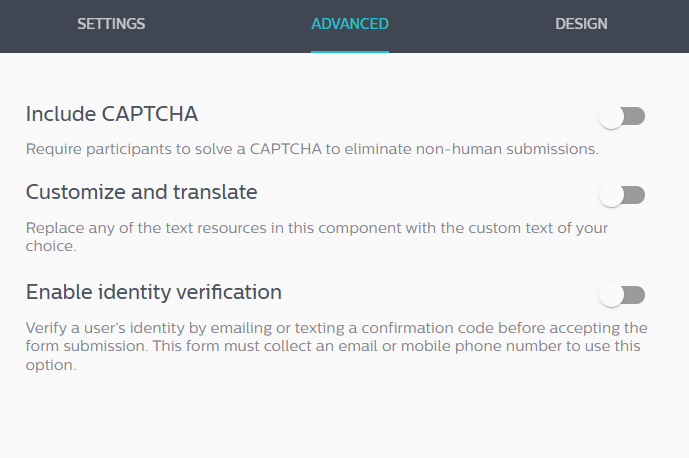
Wyng also provides data verification before collection, ensuring that you receive usable email addresses, phone numbers, and zip codes, for example. In addition, Wyng helps you stay compliant with GDPR and other data regulations by providing opt-in and consent fields.
Landing Pages: ShortStack provides a drag-and-drop landing page builder with custom widget interactions, Wishpond offers A/B tests and a full website builder, while Wyng offers the Experience Studio for broad publishing options.
| ShortStack | Wishpond | Wyng |
|---|---|---|
⭐⭐⭐ | ⭐⭐⭐⭐⭐ | ⭐⭐⭐⭐⭐ |
ShortStack doesn’t distinguish between forms and landing pages, instead allowing you to embed form widgets within landing pages. Other than forms, the landing page builder includes the typical widgets you can expect from a standard builder:
- Image
- Video
- Buttons
- Rich Text
- Countdown Timer
It also lets you define “if this, then that” interactions between widgets using the Action Widget. And if you want more complex logic or custom page elements, the Code Widget accepts user-defined JavaScript, HTML, and CSS code.

ShortStack lets you organize widgets into sub-pages using paging containers with their own URLs and navigation links.
Wishpond offers a drag-and-drop landing page builder with all the same widget options as ShortStack. However, unlike the other platforms, it lets you specify the exact position of widgets down to the pixel, instead of snapping them to a predefined layout. This gives you more control over the appearance of your landing pages.
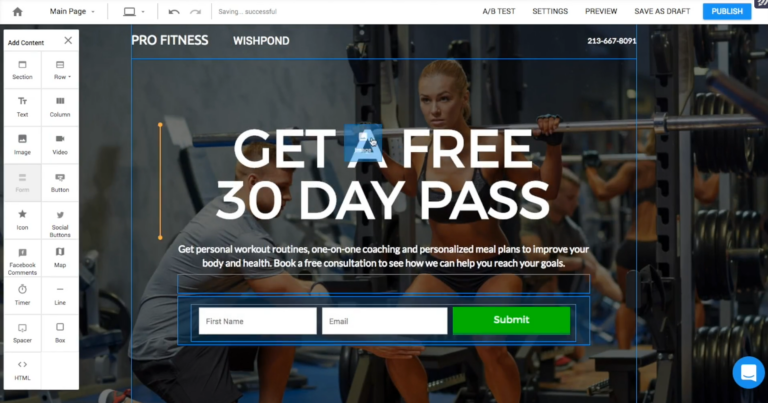
If you need to optimize your landing page, Wishpond includes A/B testing for various widgets and components. You can also split-test the entire page and different variations of it.
Wishpond recently introduced a website building tool that allows you to build entire custom websites, not just individual pages. You can host your website on Wishpond’s subdomains. Or if you need custom hosting, specify a domain name to host your website on. It also provides an AI tool for generating content so you can get up and running quickly.

Wyng allows you to publish any Experience you build as a landing page. Using Experience Studio, you get the same amount of customization options throughout your whole process. Even though Wyng doesn’t offer as many native widgets for building landing pages as ShortStack or Wishpond, it makes up for it with custom HTML, JavaScript, and CSS code. Moreover, it offers more layout options, including a Flex Grid which adjusts dimensions to match its content.
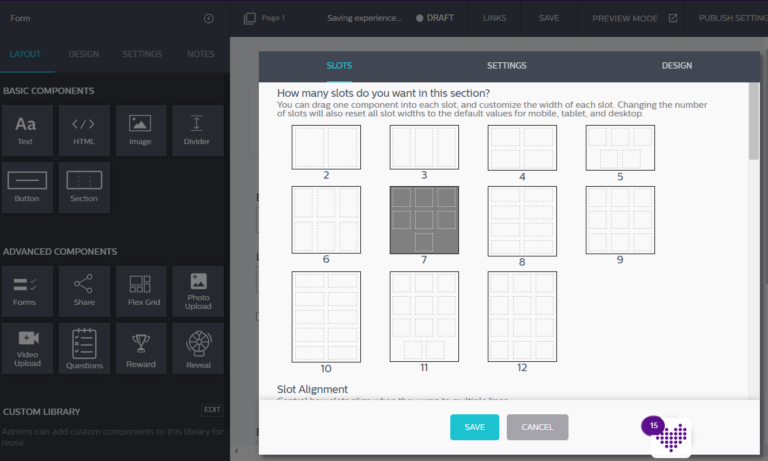
You can optimize your Wyng landing pages with custom URLs and SEO meta tags. Additionally, Wyng lets you host your landing pages on a custom subdomain that fits your brand.
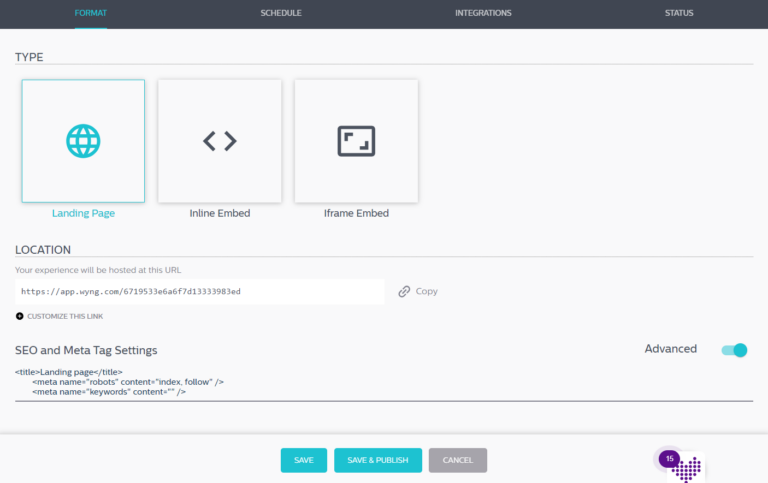
What’s more, with Wyng you can turn any landing page into a product sales page. Simply assign a product to a page element relevant to that product, Wyng tags the product then links directly to your store. It syncs up with your product store to skip manual updates and even uses customer preferences to personalize product recommendations.
Pop-up and Overlay Tools: Wishpond offers customizable pop-ups with rules and triggers, ShortStack doesn’t offer pop-up options, and Wyng supports custom setups with inline embeds and the Moments feature.
| ShortStack | Wishpond | Wyng |
|---|---|---|
⭐⭐⭐ | ⭐⭐⭐⭐⭐ | ⭐⭐⭐⭐ |
ShortStack pop-ups don’t drop down, slide across, or cover the screen automatically. Website visitors must click the form link for the pop-up to appear as an overlay on the screen.
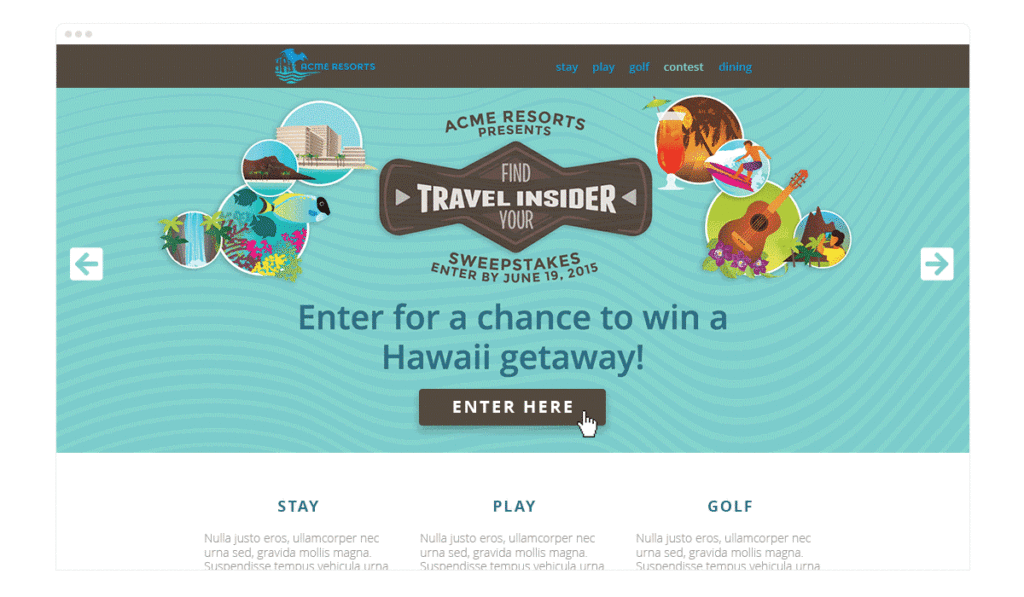
ShortStack simply lacks pop-up customization options. You must either deploy the form or landing page as a standalone web page with its own URL or embed the pop-up link in your existing website.
On the other hand, Wishpond gives you full control over where, when, and how your pop-ups appear. For example, you can set pop-ups to appear on page entry, exit, or after the visitor has scrolled a certain percentage.
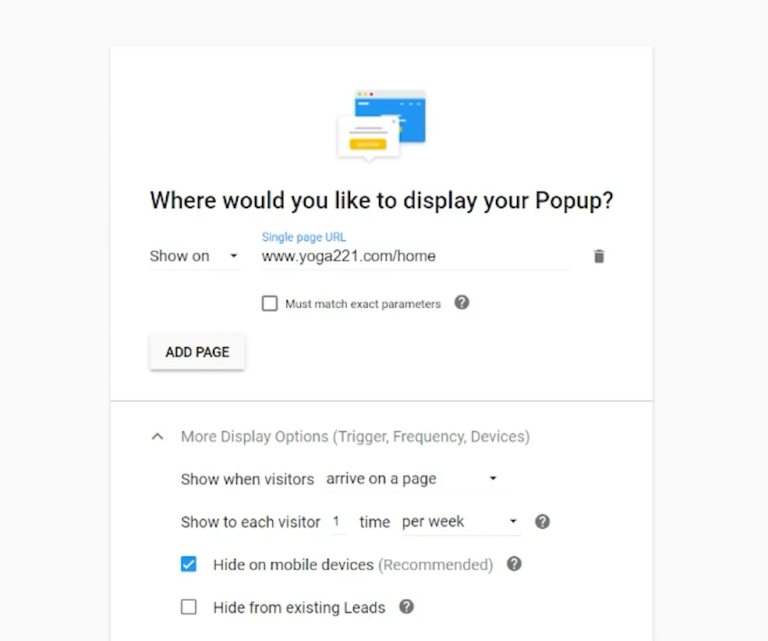
Wyng provides an inline embed HTML code, allowing you to customize how to display the pop-up on your website. It also supports websites that can’t use inline embeds by providing an iFrame embed. But it’s worth noting that iFrame embeds are not page responsive and have a visible scroll bar.

What truly brings pop-ups to life in Wyng is the Moments feature. It deploys targeted pop-ups or embedded experiences across your site, triggered by specific user behaviors, attributes, or URL patterns. This ensures you’re presenting the right experience to the right person at the right time.
ShortStack vs Wishpond vs Wyng: Data Collection and Personalization
ShortStack focuses on collecting and storing data, Wishpond uses collected data to drive automated workflows, and Wyng provides privacy-focused control over data collection and utilization.
| ShortStack | Wishpond | Wyng |
|---|---|---|
⭐⭐⭐ | ⭐⭐⭐⭐ | ⭐⭐⭐⭐⭐ |
Leads Database: ShortStack offers a basic leads database, Wishpond’s database provides more information for automation, and Wyng gives you full control over data models, identity resolution, and data retention.
ShortStack maintains a database (called List) of profiles extracted from submitted form entries. It creates separate lists for each campaign that contains a form and only stores the information captured in each form. It also lets you import lists from social media or other external sources (only on the business plan or higher).
Each entry in a list is fully editable, allowing you to add in missing information, correct mistakes, or swap out bad entries before displaying them to participants. The email list manager also includes entry labeling, vote adjustment, and entry approval actions.
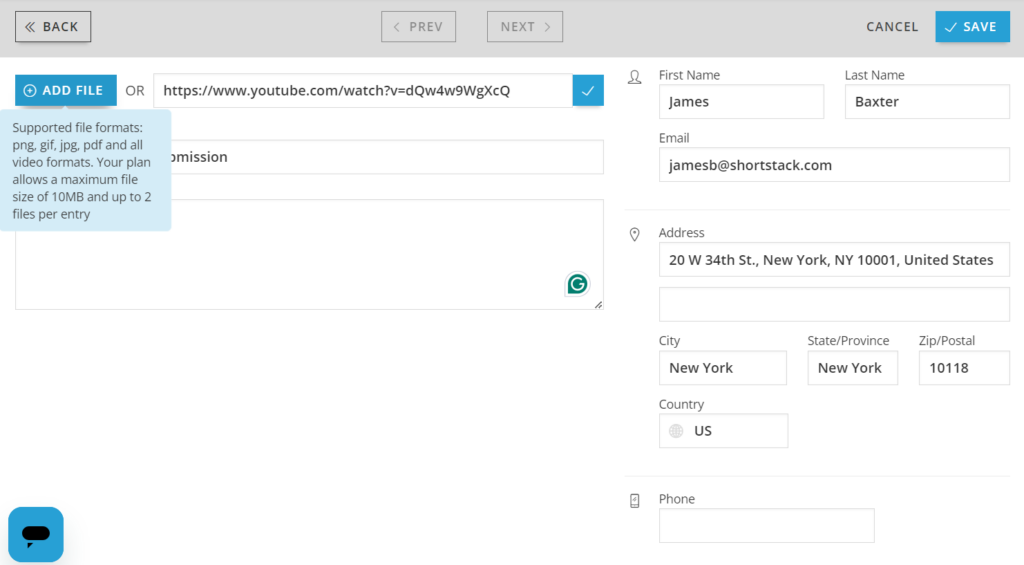
When choosing random winners for video and photo contests from the specific list, ShortStack lets you choose the number of winning entries, label winners, and prioritize entries with more votes or action points.

Wishpond provides a Leads database as part of its marketing automation tools. Selecting a single lead shows its profile, containing information like name, email address, and phone number. The database also tracks clicks, conversions, entry submissions, and other interactions the lead performs with your email campaigns.

Leads are automatically added to Smart Lists which are then updated based on lead activity. But, you can create Static Lists and manually populate them with lead profiles.
The Visitors list is a streamlined version of the Leads database for anonymous visitors. It doesn’t capture profile information but still tracks their activities across all your campaigns. This way, you have a quick overview of campaign visitors who fail to convert.
ShortStack and Wishpond offer basic lead databases that are populated and managed for you. But what happens when you need more control over customer data?
With Wyng Profiles, you get all the control and flexibility you need.
Wyng gives power data back to the customer, allowing them to specify what data they want to share. You, on the other hand, can control what data you want to receive. Specify custom attributes using data models so they become integral parts of your Experiences rather than ordinary form fields.

Wyng can build profiles for anonymous users even before they submit any personal information. That’s because it assigns a unique identity to each anonymous user, allowing privacy-first personalization for even unknown visitors. Furthermore, it can track activity from multiple anonymous sessions into a single customer profile.

Unlike other platforms, Wyng adapts to your customer’s preferences over time, allowing you to define relevance and retention windows. These tools automatically delete the specified attribute once the window expires, emphasizing the commitment to zero-party data collection.
Integration with Customer Journeys: ShortStack provides Webhooks for integrations, Wishpond has basic automated workflows, while Wyng offers simple automated sequences and robust customer journey integrations.
ShortStack only provides form integrations with Google Maps and Mailchimp, allowing you to send captured data to these platforms. You can also use a Webhook to create non-native integrations but this requires some setup and custom field mapping.
Wishpond offers ad-hoc customer journeys using automated workflows. But this tool is nowhere as powerful as the workflows in marketing platforms like Salesforce and Hubspot.
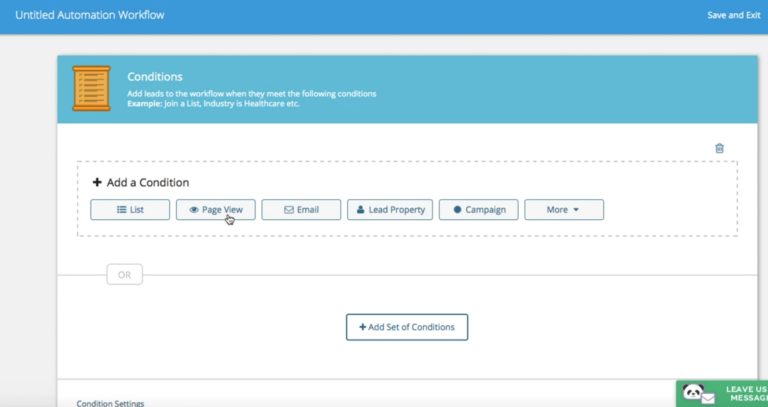
If you need proper customer journey tools, you must integrate with a third-party marketing platform.
Wyng focuses on seamless integrations with platforms that properly support customer journeys.
It’s designed to complement third-party platforms, offering powerful data capture tools and improving the quality of your data.
However, Wyng also has its own Moments feature that lets you create simple automated sequences, allowing you to display targeted content to your customers at the right time, guiding them to your desired outcome. As mentioned before, it deploys targeted pop-ups on your site, triggered by specific user behaviors, attributes, or URL patterns.
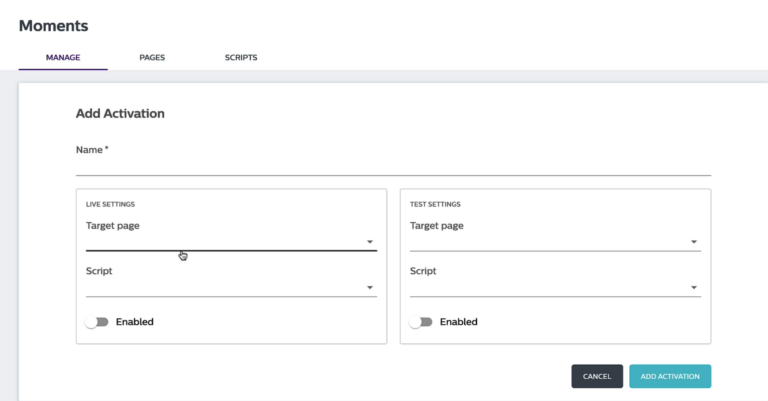
Personalization: ShortStack doesn’t provide personalization tools, Wishpond offers customer segmentation for workflows, and Wyng offers full personalization for Experiences.
ShortStack doesn’t offer any dedicated personalization features. You can hide or display content on forms and landing pages based on customer attributes, but there is no tool for automating this process.
On the other hand, Wishpond offers customer segmentation which you can use in automated workflows. Simply chain conditions together using AND/OR logic and filter customers based on:
- List: customers that belong to a specified list.
- Page view: customers that have viewed a set page over a specified period.
- Email: customers that have received, opened, or clicked on a link inside an email.
- Lead property: specific profile attribute that matches a set value.
- Campaign: customers that have or have not converted on a previous campaign.
- Workflow: customers that have started or completed a set workflow.
- Custom event: customers that match any custom event defined in the API.
When it comes to personalization, Wyng is unparalleled by either platform.
It features Wyng Segments, which you can use to fully personalize content within Experiences. For example, the content can change based on whether it’s a customer looking for travel tickets or another that needs baseball game tickets. Within a UGC display, these two customers can see completely different content.

Furthermore, the Segments feature lets you skip or change certain questions in quizzes based on previously collected customer data or offer different rewards in scratch-offs and spin-to-win Experiences, rather than generic ones. New customers, for instance, can be rewarded with a sample, while repeat customers get loyalty points.
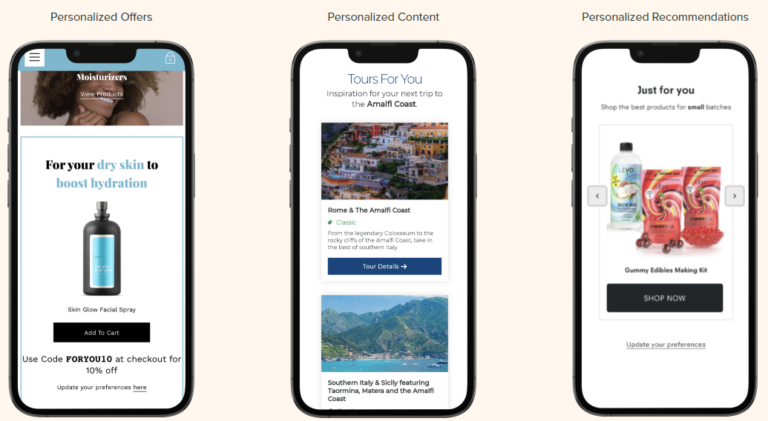
Wyng also provides open APIs and SDKs for Experiences and Profiles, which allow you to pull data from another website and show personalized emails and content based on attributes like zip code and phone number.
ShortStack vs Wishpond vs Wyng: Analytics and Reporting
ShortStack has basic campaign analytics, Wishpond has real-time reporting dashboards but focuses on email performance, and Wyng has a dedicated Metrics feature with powerful Experience analytics.
| ShortStack | Wishpond | Wyng |
|---|---|---|
⭐⭐⭐⭐ | ⭐⭐ | ⭐⭐⭐⭐⭐ |
ShortStack provides a basic analytics page for each campaign in your library. It groups your performance metrics into four categories:
- Traffic
- Clicks
- Entries
- Sharing
- Autoresponder
The Traffic category shows where your views are coming from geographically, by device type, and by environment (web, Facebook, embedded).

The other categories provide an overview of user engagement with your campaign, capturing metrics like shares, form submissions, and open rate.
Wishpond allows you to track the performance of your promotions within its reporting dashboard. However, its main focus is on email analytics, showing the number of emails sent in each campaign, as well as the number of opens, clicks, and captured leads.
In contrast to both platforms, Wyng provides a dedicated Metrics feature with powerful analytics on all your Experiences. It features seven report dashboards, each showing a comprehensive overview of key metrics:
- Overview: At-a-glance performance indicators
- Visitors: Audience demographics and sources
- Engagement: User interaction metrics
- Forms: Submission and completion rates
- Click-Throughs: Link performance analysis
- Shares: Social sharing metrics
- Content: User-generated content engagement

Wyng also collects Profile Metrics, where you can see all the customer profiles you have captured. This feature allows you to track metrics like:
- Active Profiles: how many profiles were created or edited within the last month.
- Count of Profiles: how many of your total profiles are included in your filter.
- Attribute Completion: what profile attributes are most popular in your data set.
ShortStack vs Wishpond vs Wyng: Pricing
ShortStack’s pricing increases with the number of stored entries, Wishpond doesn’t have public pricing information, and Wyng doesn’t have any plan limits or lock features in higher plans.
| ShortStack | Wishpond | Wyng |
|---|---|---|
⭐⭐⭐⭐ | ⭐⭐ | ⭐⭐⭐⭐⭐ |
ShortStack has a simple pricing model that scales up with the number of monthly form entries. Its paid plans start at $49/mo for 2,000 stored entries and go all the way up to $499/mo for 200,000 stored entries. Higher plans also unlock more features like video contests and points for actions on the Pro plan.
It also offers a free trial that only allows 20 stored entries.
Wishpond’s pricing is not public, so you’ll have to contact their sales team for a demo and price quote. However, signing up for a demo gets you a free trial and a guided tour of the platform.
Wyng has a usage-based pricing model that scales up or down with businesses. There are no limits on user seats, the number of experiences you can build, API calls, or the number of integrations you can set up.
Its pricing is tailored to your enterprise, its unique needs, and the flexibility you need. As a result, there’s no fixed price. Instead, Wyng accommodates you at your budget and desired features. Contact Wyng for more information!
Generally, Wyng is a self-service platform, but for marketing campaigns that go the extra mile, the Wyng Services specialist team provides strategic and technical support. Wyng offers full-service models as well as hybrid models, where a dedicated team helps you out as much as you need.
ShortStack vs Wishpond vs Wyng: Pros & Cons
 | |
ShortStack Pros | ShortStack Cons |
| ✅ Powerful entry voting tools | ❌ Limited user engagement tools |
| ✅ Lots of templates | ❌ Limited pop-up options |
| ✅ Beginner friendly | ❌ Limited customer segmentation |
| ✅ Customizable widget interactions | ❌ Limited native integrations |
 | |
Wishpond Pros | Wishpond Cons |
| ✅ A/B testing on forms and landing pages | ❌ Limited user engagement tools |
| ✅ Full website builder | ❌ Limited campaign analytics |
| ✅ Automated workflows | ❌ Limited contest and giveaway tools |
| ✅ Customizable leads database | |
| ✅ Customizable pop-ups | |
 | |
Wyng Pros | Wyng Cons |
| ✅ Highly versatile Experience Studio | ❌ Pricing isn’t transparent |
| ✅ Wide array of user engagement components | ❌ No A/B testing |
| ✅ Fraud detection and identity verification | ❌ Limited pop-up options |
| ✅ Privacy-focused zero-party data capture | |
| ✅ Seamless integration with third-party tools | |
| ✅ Advanced analytics and reporting | |
| ✅ Powerful segmentation and personalization | |
Final Verdict: ShortStack vs Wishpond vs Wyng
Small business owners would love ShortStack, Wishpond is best for all-in-one marketers, and Wyng is ideal for enterprises with unique and complex user engagement approaches.
| ShortStack | Wishpond | Wyng |
|---|---|---|
Best for: | Best for: | Best for: |
These three platforms seem to perform similar functions but they cater to vastly different audiences. ShortStack is best for small businesses that need a simple platform to run social media contests and collect user entries. Wishpond includes various marketing campaign tools catering to businesses that need an all-in-one platform. Meanwhile, Wyng is ideal for enterprises that need a powerful and highly customizable platform for running complex, interactive, and engaging promotions to securely collect zero-party data.
Use ShortStack if:
- You like having lots of template options to get started quickly.
- You need a simple landing page builder without extra features.
- You need robust contest voting functionalities.
Click here to get started with ShortStack!
Use Wishpond if:
- You need an all-in-one marketing platform.
- You want to optimize landing pages with A/B tests.
- You want to build a full website.
Click here to get started with Wishpond!
Use Wyng if:
- You need a powerful builder for all kinds of interactive experiences.
- You need to securely scale your digital promotions strategy across brands and geos.
- You want to upgrade your tech stack with powerful engagement and lead capture tools.






